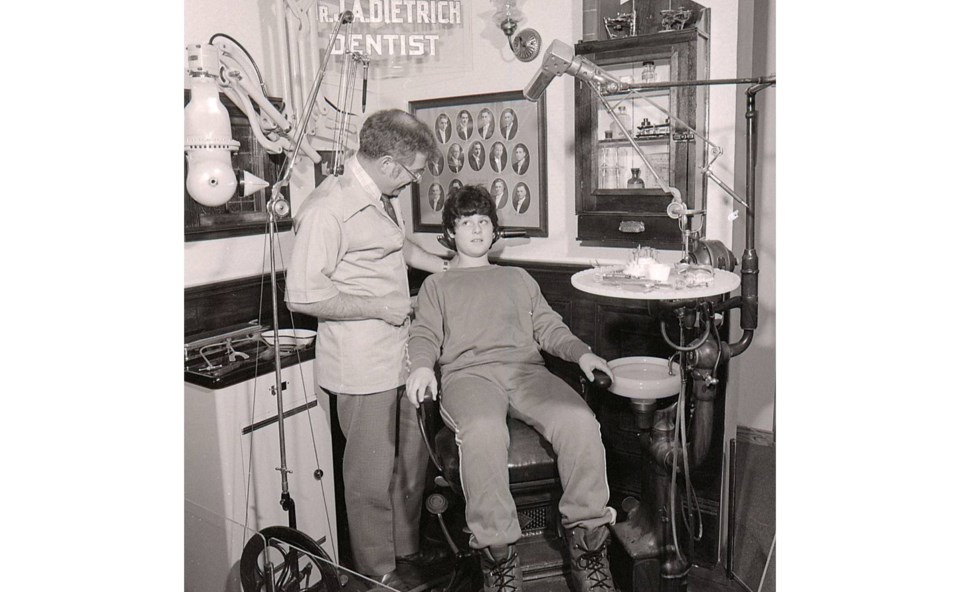From the archives of the Sault Ste. Marie Public Library:
How do you feel about visiting the dentist? No matter how anxious you might feel about going to see a dentist, it is probably safe to assume that your visit would be a far less traumatic experience today compared to the nineteenth century!
For those living in Algoma in the 1800s, dental care was probably not a high priority for many of the residents and they were unlikely to seek any help unless they were experiencing a painful toothache.
The common treatment for this ailment was extremely painful so people had to weigh the balance between the pain of the toothache and the pain of the treatment! Most of the dental traditions descended from the French methods of “bloodletting and tooth drawing”.
The 'dentists' of the early to mid-1800s had no way to pull the tooth until it was loose enough for them to get a hold of. With no special tools for this purpose, the patient was put in a tub of water and then the affected molar was split with a chisel! To kill the nerve in the tooth, a small hot iron was then applied to the tooth.
Generally, the pain would go away within a few hours after this “treatment” was done. In a few days, the patient would return, the tooth would be loose enough by now and it could then be pulled! It is difficult for us to even imagine how painful this practice would have been.
With these methods of treatment being followed, it was clear to many that dentistry needed to be regulated and there needed to be training in appropriate methods for dental care.
On March 4, 1868, a bill was passed that made world history. It was the first bill to regulate dentistry in the world. The wording of this new law stated that “Required persons practicing dentistry be examined by a competent board as to their qualification.”
The Royal College of Dental Surgeons (R.C.D.S.) was established and the first school of dentistry opened. It consisted of a lecture room and infirmary. The course lasted for four months, followed by an apprenticeship lasting for two years and the cost of tuition was $100. Before long, it was affiliated with the University of Toronto and the course of study was lengthened to three years.
With this formal training in dentistry now standard, Sault Ste. Marie looked forward to getting a dentist to open a practice here. Dr. J.A. Shannon graduated in 1888 as a formally trained dentist.
Upon his graduation, he began practicing in Southern Ontario in Dutton, Ontario and then moved to Sault Ste. Marie in 1895 to become one of the first dentists practicing here.
His mother was part of the prominent Adams family and his uncle, Dr. William Adams was a medical doctor practicing here, so with this family connection, he was encouraged to come to Sault Ste. Marie. He built a new home at 659 Queen Street East, directly across from the Leland Hotel and then set up his dentistry practice in his home.
Dr. Shannon and his wife had four children and his daughter, Marion Shannon lived in the house until around the early 1970s. Dr. Shannon became an active member of his new community. He served on City Council, the School Board, the YWCA, Central United Church as well as Chairman of the PUC from 1917 to 1946. By the time of his death in 1946, he had witnessed many more dentists arrive and set up practices, including his own son, Dr. George Shannon who joined him in his practice in 1919.
With so many more dentists practicing in the city, methods for treating dental problems certainly improved over the years and a trip to the dentist nowadays is not normally something to be feared. As we now know, prevention of dental problems starts with nutrition and proper brushing and cleaning of our teeth.
In 1984, local dentist, Dr. Terry Kearns, brought back a glimpse of what a dentist's office looked like during the first half of the twentieth century.
While visiting Toronto, a friend mentioned that she had her father’s dental office equipment stored in her basement and was looking for someone who would be interested in acquiring it. Her father, Dr. Joseph Dietrich had graduated in 1922 and then practiced for 54 years.
Dr. Kearns decided to bring the antique equipment back to the Sault with him. When he moved his practice to the Churchill Plaza in 1983, he was able to work with local architect Perry Short and design a special space in his new office to exhibit this antique dentist's office!
This display included a hydraulically operated chair from 1908, a treadle-powered dental unit from 1915, and a mid-1930’s vintage X-ray and sterilizing equipment.
A photo of Dr. Dietrich’s 1922 graduating class was prominently displayed on the wall. For many older people, this display probably reminded them of their earliest visits to the dentist.
With the advent of the power drill and more recent advances, a trip to the dentist is no longer something to be feared. Fortunately, it is unlikely that any of us visiting our dentist’s office recently have encountered a chisel as one of the tools being used in dental treatments!
Each week, the Sault Ste. Marie Public Library and its Archives provides SooToday readers with a glimpse of the city’s past.
Find out more of what the Public Library has to offer at www.ssmpl.ca and look for more Remember This? columns here
